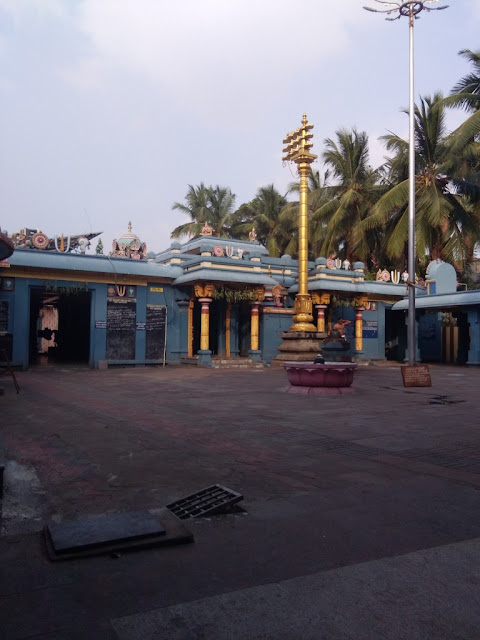Lakshmi Narasimha Temple (Navaneetha Krishnan Temple),
Nanganallur – The Temple
The temple is facing east with 5 tier Rajagopuram with seven
Kalasams in the midst of residential area. The Rajagopuram is about 55 feet
high and 30 feet wide. The doors of the Rajagopuram contain intricately carved
floral designs and images of the Lord's incarnations. The temple complex covers
about 10 ground land. Dwajastambam, Garudalwar and Balipeedam can be found
facing the sanctum. Presiding Deity is called as Lakshmi Narasimha. The main
sanctum, facing east enshrines the imposing image of the Presiding Deity, Lord
Lakshmi Narasimha.
Lord Pradosha Narasimha can also be found in the sanctum
along with presiding Deity. Special worship is performed during every Pradosha
to this Pradosha Narasimha and to Chakrattazhvar (Sudarsana) also. Idols of Vishwaksenara,
Nammazhvar, Ramanuja and Vedanta Desika can also be found in the sanctum. An
interesting and rare architectural feature of this sanctum is a circular shaped
pillar which resembles a stambha from which Lord Narasimha emerged to protect his
child-devotee Prahlada.
The shrine housing the image of Sudarsana with
Narasimhar at the back is designed like a chariot, circular in shape. The
vimana is one of the chief interests about the temple and is known as Veda
chakra Vimana. Interestingly, the “prayoga chakra` (the discus held by Lord
Narayana just prior to release) of an old Pallava Vishnu image which was
earlier excavated here, has been installed in front of the Chakrattazhvar
shrine, which has enhanced the traditional grandeur of the temple. This
exceptional Vishnu image is properly mounted on a small structure, enabling
devotees to actually touch it and pray for their wishes.
There is another significant shrine dedicated to Lord Navaneetha
Krishnan can be found in the temple premises. Here, the main image holds a ball
of butter in his right hand while his left hand holds the conch. It is
interesting to note that the shrine for Lord Krishna is octagonal (eight-sided)
in shape. The myths and legends associated with the temple reveal that the
octagonal design of the temple has a special significance. According to these
stories since he was the eighth child of Vasudeva and Devaki, the shrine
dedicated to the Lord is octagonal in design.
There is also another important shrine dedicated to Lord
Srinivasa in the Temple premises. A tall
Dwajastambam can be found facing this shrine. This Idol is provided as the gift
from the Tirumala Tirupati Devasthanam. There is a shrine dedicated to Lord
Kothandarama with Sita Devi, Lakshmana and Hanuman in the temple premises. There
is an Idol of Hanuman called Bhaktakoti Anjaneya, found opposite to this Shrine
located inside a prayer hall. The devotees are permitted to offer and apply
butter on the image, while praying for the fulfillment of their wishes. So, the
Anjaneyar here is seen always with butter alangaram.
There is another shrine of Hanuman located just outside
the prayer-hall and facing the shrine of Lord Rama. He is called as Sanjeevi
Anjaneya. There is also a separate shrines for Azhwars with exclusive cubicle
for each Azhwar in a neat row. There is a beautiful circular chamber of mirrors
with a beautiful and unusual gopuram that adds a charming view to the temple.
The decorated images of the Lord are taken on special occasions near these
mirrors. Inside the chamber, four pillars carrying the image of Lord Narasimha
can be found. Throughout the entire length of the wall there are a series of
mirrors reflecting the images.
Apart from these, pictures of the deities of 108 Divya Desams
adorn the walls. The paintings of the walls are outstanding and depicting the
thirty pasurams of the Tiruppavai. Pictures of some Divya Desams are found on
the external wall, thus making the chamber really a `House of Art`. The inner
chamber is fitted with strategically placed, large-sized mirrors, which give
the viewer a multi-reflection of the images of the deities placed within. Sthala
Vriksham is Peepal Tree.

























